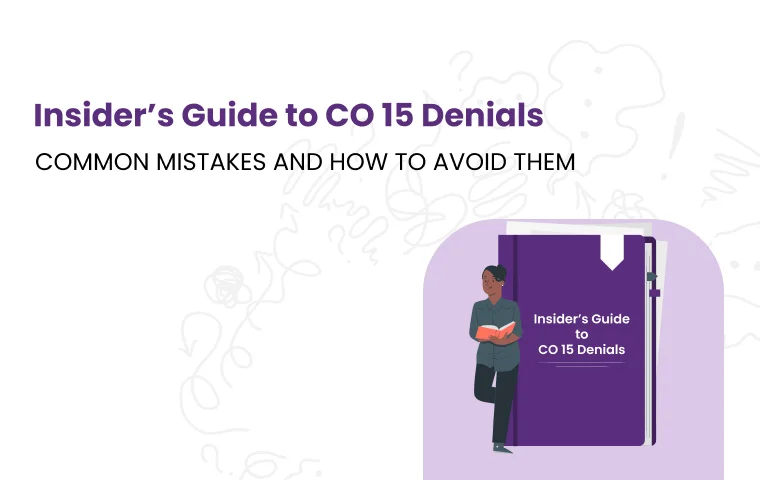Imagine this: You've meticulously prepared a claim, double-checked every detail, and finally submitted it, only to receive that dreaded CO 15 denial code in response. Your claim hits a roadblock, and the reason is... "missing or invalid authorization." Frustrating, right?
Authorization denials like CO 15 are one of the most common—and misunderstood—challenges in medical billing. They’re tricky because, while the solution might seem straightforward (just get the authorization!), there’s actually a maze of steps and checks involved. Missing even one can result in a denial that costs valuable time and reimbursement.
In this insider’s guide, we’re not just going to tell you how to “fix” CO 15 denials; we’re diving deep into the most common pitfalls that cause them in the first place and, more importantly, how to prevent them altogether.
By the end, you’ll be equipped with the knowledge to not only resolve CO-15 issues but avoid them entirely, keeping your claims flowing and your reimbursements timely.
What is CO 15 Denial Code?
The CO 15 Denial Code is a specific claim denial code used in medical billing to indicate an issue with the authorization of services. The official description is:
"Payment adjusted because the submitted authorization number is missing, invalid, or does not apply to the billed services or provider."
In simpler terms, a CO 15 denial means that the payer (usually an insurance company) has rejected the claim due to problems with the authorization process required for certain medical services.
Key Reasons for CO 15 Denial
1.Missing Authorization:
The claim was submitted without including the required authorization number, which is often mandatory for specific services or treatments.
2.Invalid Authorization:
The authorization number provided doesn’t match the services, provider, or date range indicated on the claim. This can happen if the number was input incorrectly or if the authorization applies to a different service or provider.
3.Expired Authorization:
If the authorization wasn’t renewed on time or expired before the services were rendered, the claim will be denied under CO 15.
4.Authorization Mismatch:
When the details in the authorization (e.g., specific procedures, providers, or dates) don’t align with what was actually billed, a CO 15 denial can occur.
What's Next If You Have Encountered The CO 15 Denial Code?
If you've encountered the CO 15 Denial Code, it’s essential to take systematic steps to resolve the issue and ensure proper payment. Here’s a step-by-step guide to help you address CO 15 denials effectively and minimize delays in reimbursement:
1. Review the Denial Reason Thoroughly
-
Start by reviewing the exact reason for the denial provided by the payer. Sometimes CO 15 denials may be triggered by minor details, such as a missing digit in the authorization number or a simple date mismatch.
-
Ensure you understand why the claim was denied before making any adjustments.
2. Check the Original Authorization Requirements
-
Verify if the services rendered actually required pre-authorization. Different insurance plans and payers have varying rules for what services need authorization, so it’s crucial to confirm if it was necessary.
-
If authorization was required but missing or incorrect, move to the next steps to resolve the issue.
3. Verify the Authorization Number and Details
-
Check the authorization number provided on the claim from in block number 23. Ensure it matches the services rendered, the specific provider, and the dates of service.
-
Sometimes authorization numbers are input incorrectly or fail to align with the service details. Double-checking these specifics can prevent resubmission errors.
4. Contact the Payer’s Customer Service
-
Contact the payer to get clarification on the denial. Payer representatives can often provide additional insight on why the authorization was deemed invalid or insufficient.
-
They may also advise on any documentation needed for resubmission or confirm if you’re able to appeal the denial.
5. Obtain or Update Authorization, if Necessary
-
If the claim lacks authorization entirely, work with the ordering provider or hospital to secure the necessary authorization. If the authorization expired or didn’t cover the service, request an update from the provider.
-
In cases where services were already rendered without authorization, request a retrospective authorization, if the payer allows it.
6. Document Everything
-
Maintain thorough records of every interaction with the payer, any new authorizations obtained, and the steps taken to correct the denial. This documentation can be critical if there’s a need for further appeals or audits down the line.
7. Resubmit the Corrected Claim
-
Once you’ve confirmed and corrected the authorization information, resubmit the claim with the updated details.
-
Be sure to include any additional documentation the payer requested and clearly indicate that it’s a resubmission due to authorization issues.
8. Monitor for Payment or Further Denial
-
After resubmission, keep an eye on the claim’s status. Sometimes payers may process the corrected claim quickly, but in other cases, you may need to follow up to ensure it’s processed.
-
If the claim is denied again, review the denial reason and consider an appeal if it’s warranted.
If Pre Auth Was Not Taken What Should You Do Now?
If you encounter a CO 15 denial due to missing pre-authorization, don’t worry—there are several steps you can potentially take to recover payment. Here’s what to do if pre-authorization isn’t obtained:
Check Payer Policies for Retrospective Authorization
First, confirm whether the payer allows retrospective (or retroactive) authorization. Some payers permit retroactive authorization if you can justify the medical necessity of the service.
This approach typically applies when authorization was missed due to an emergency, oversight, or other exceptional circumstances. Be prepared to explain why pre-authorization wasn’t obtained initially.
Request Retrospective Authorization from the Ordering Provider
Contact the ordering physician or healthcare provider involved in the treatment and request that they submit a retrospective authorization. They may need to provide supporting documentation explaining the necessity of the service and the reason for the missed pre-authorization.
Ensure all relevant information (service type, dates, codes, and patient details) is included in the authorization request.
File an Appeal with Supporting Documentation
If retrospective authorization isn’t allowed, you can still file an appeal with the payer. In your appeal, include a letter of medical necessity from the provider, explaining why the service was critical and the circumstances that prevented pre-authorization.
Include any relevant clinical notes, test results, and additional documentation that supports the medical need for the service. The stronger your evidence, the higher your chances of getting the denial overturned.
Highlight Any Urgent or Emergency Aspects
If the service was provided in an emergency situation, emphasize this in your appeal. Payers often have different standards for emergency services, and some may waive the pre-authorization requirement if the treatment was provided in an urgent or life-threatening situation.
Emergency claims usually need to show documentation that justifies the immediate nature of the treatment.
Submit the Claim with Additional Information
If allowed by the payer, resubmit the claim with a clear explanation of why pre-authorization wasn’t obtained. Some payers allow additional documentation to explain unusual circumstances.
Be sure to label it as a resubmission and attach any additional information that supports your case.
Follow Up with the Payer
After submitting the claim or appeal, monitor the status closely. Contact the payer’s customer service team if you don’t see updates within their typical processing time. Staying proactive can help ensure the claim is processed without further delays.
Set Up Safeguards for Future Claims
To prevent missing pre-authorizations in the future, consider implementing a pre-authorization checklist or workflow that triggers a pre-authorization review before claims are submitted. Billing software or EHR systems with authorization alerts can also help ensure that no claims slip through without the required approval.
Preventive Steps You Need To Take To Avoid CO-15 Denials In the Future?
To avoid future CO-15 denials and keep claims flowing smoothly, implementing preventive measures is vital. Here’s a comprehensive list of proactive steps you can take to reduce the chances of a CO 15 denial due to missing or incorrect authorizations:
1. Establish a Pre-Authorization Verification Process
2. Use Software Tools to Track Authorizations
3. Create an Authorization Log for Each Patient
4. Communicate with Payers Regularly
5. Verify Details Before Submitting Claims
6. Monitor Expiration Dates on Authorizations
7. Educate Your Team on Specific Payer Requirements
8. Maintain Good Communication with Ordering Providers
9. Conduct Regular Audits
10. Develop an Escalation Process for Authorization Issues
How Can HMS USA LLC Help With Coping With CO 15 Denial Code?
HMS USA LLC simplifies CO 15 denial management with an advanced denial management system and automation that reduces errors, tracks authorizations, and expedites claim resolution. Our expertise in payer-specific requirements and proactive monitoring prevents denials before they occur, while our team handles all payer communications for you. With HMS, you get faster reimbursements, fewer denials, and more time to focus on patient care.
ABOUT AUTHOR

John Doe
As a blog writer with years of experience in the healthcare industry, I have got what it takes to write well-researched content that adds value for the audience. I am a curious individual by nature, driven by passion and I translate that into my writings. I aspire to be among the leading content writers in the world.
